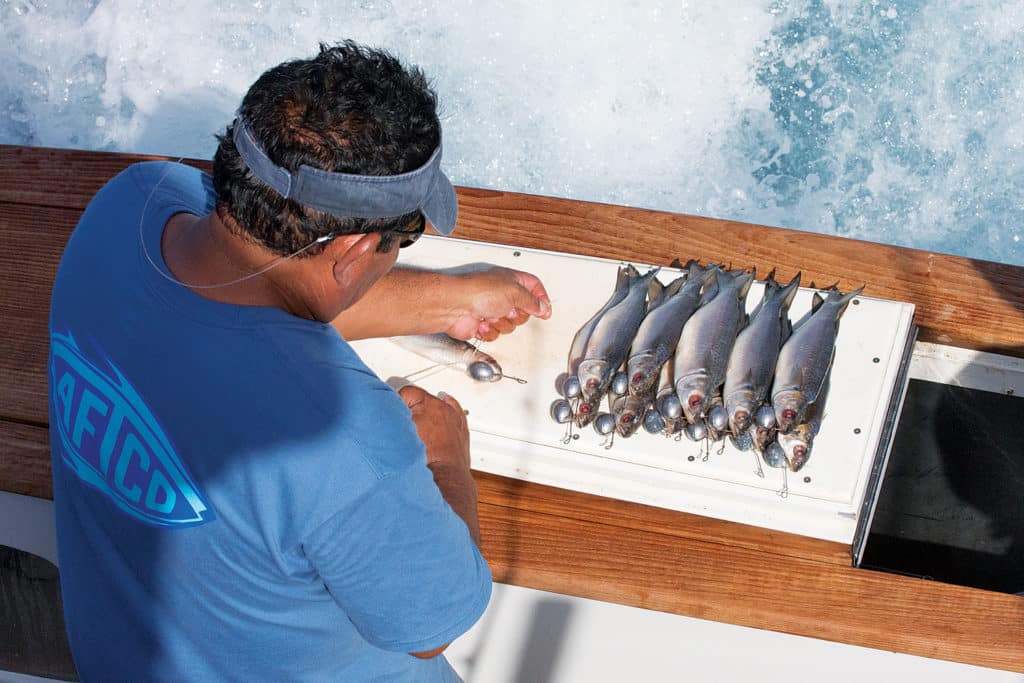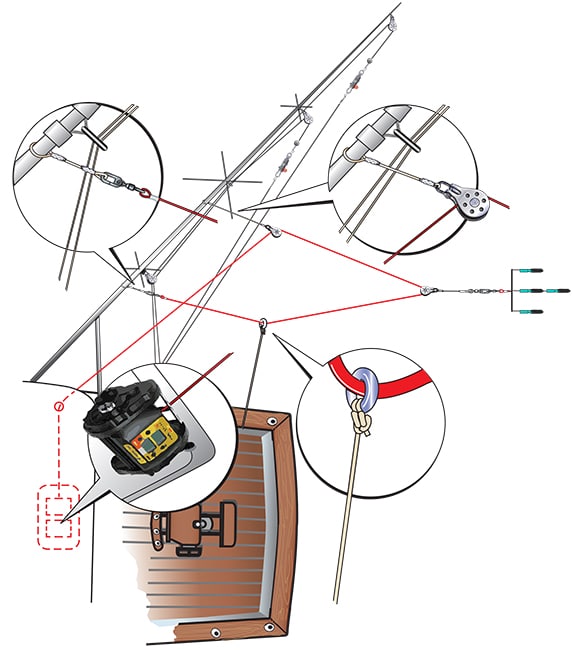
Dredge To Catch
Unless you’ve been living under your console for the last 20 years, you’ve seen the results of what dredges can do for raising fish. The dredge has arguably become the single most important factor in the success of just about anyone who knows how to rig and fish them properly. The advancement of dredge fishing in general has been like a military arms race: If a single bait off each loop was working good, two would be better; if a single dredge worked well, then stacking two or three in a row would be even better than that — and it is.

The dredge is not only a staple on the sailfish circuit, it has become a necessary tool to be competitive in virtually every billfish sport fishery around the globe, except the big black marlin fishery in Australia and for sight-fishing at Catalina. If you are fishing a points tournament where there are different points for blues, whites and sailfish in the Bahamas, Gulf, Caribbean, East Coast or wherever, and you are not fishing a dredge, you are not going to compete with those who are — it’s that simple. You might catch and weigh a big blue marlin, but that might not be enough to win on a point-per-pound scenario. You have to read the rules and determine what is the best way to earn the most points per day given the current fishing conditions at your location.

Bring Lots of Dredges
You need a minimum of six dredges of various sizes with swivels and droppers attached ready to go as primary dredges, whether you fish two or three per side, and you need at least another six rigged complete for backups. You need the backups because bad things happen: You can cut your dredges off, the arms can break over time, and, occasionally, we’ve had explosive bites from wahoo, mako sharks, sailfish and marlin that annihilated our dredges. I’m talking about bites where the fish explodes up through the dredge, breaks it off, and jumps away wearing our dredge as a headdress. Those are awesome bites to see, but it’s unfortunate to lose all that gear at one time.
That is only a partial list of the consumable tackle for a four-day tournament; you also need around one hundred pre-cut, wind-on leader sections to get started. If fishing is good and you have bonito, dorado and other bites to contend with, you’d better have 150 to 200 leaders per day ready to go. You still need a minimum of six, but really eight or 10 matched-set rod and reel combos, each spooled with line so you can do a quick swap out when attacked and re-set them once your gear is back out.
You can forgo all the bait rigging for the dredges by using rubber fish or plastic squid instead of bait — and you will see fish that way — but you will not compete with the crew working a full spread of dredges rigged with fresh baits. We have had some good days white marlin fishing with a Mold Craft squid dredge; if you are not fishing several days in a row, an artificial dredge is better than not using one, in most cases, so they have their place in your war chest.

Use Beefy Hardware
We use sailboat hardware made by either Harken or Ronstan and are known as “blocks” for our pulleys in various sizes, depending on the location of the pulley. We also look at the load it can carry and that it swivels so that they adjust accordingly as needed. Be sure to use quality pulleys that can hold everything and check them after the season. We replace them every year when we restring our riggers or every other year depending on their condition, how much we have fished and how much the sun has damaged them. We’ve had pulleys break, and it’s a lot of unloading gear, creating a ton of extra work. It’s very disruptive to your fishing day.
Getting your crew dialed in and doing the hard work necessary to be successful dredge-fishing pros will pay big dividends in the long run. There is no question you will raise more fish with dredges than without them, and when you raise more, you increase your chances of catching your target. Once you acquire the gear, you are ready to get to work and fill the bait box so you can get out there and see more fish.

Reel Setup When Fishing with Dredges
From the bridge S-9, we do not run our teaser lines through the hardtop because we want to be able to pull the teaser by hand when marlin fishing and also do not want the line going into and coming out of the hardtop running against hard angles. We run our teaser lines through guides and out to a pulley off the rigger about 3 feet higher than our hardtop when the riggers are up. That pulley is connected by using a 15-inch piece of 600-pound Momoi extra-hard mono that is connected to the pulley with a crimp and is then looped around the rigger twice and crimped again.

If pulling your dredges from the cockpit, the teaser reel of choice is Lindgren-Pitman S-1200 spooled with 400-pound mono, usually spliced into 200-pound Dacron to add line capacity and make for a quicker change out of the top shot if it gets damaged. Those are mounted on a short rod.
From the bridge, most top captains choose the Miya Epoch Super S-9 reel spooled with Dacron and spliced with 400-pound mono into the Dacron. We also have a set of 50 Internationals mounted along with the electric reels for pulling our squid chains. They are rigged with Dacron backing and 300-pound extra-hard mono spliced into them. We use the Super S-9R, which comes with wireless or hard-wired remotes. We hard wire and put them in the tower for retrieving our teasers when marlin fishing from up top.
No matter whether you are pulling your dredges from the cockpit for the crew to deal with or from the bridge for the captain to control, they need to connect to the dredge basically the same way. Because of the size of the dredge and the strain that they create when pulled through the water at 5 or 6 knots or faster, you need to have beefy gear to hold them and a pulley system to help retrieve them. To start, be sure you have a big back bar for your outrigger; there is a lot of pressure on it when in full dredge mode.

Lots of Preparation
Throughout the 1990s, the cleaning stations at various host marinas for the winter sailfish tournaments in Stuart were very busy places. It was, and still is, common to see crews gathered at 4 a.m. to start rigging fresh mullet and ballyhoo for their dredges as well as their hook baits. Now, crews even carry lightweight plastic banquet tables with sections of PVC pipe for legs to raise them up to bench height so they can rig behind the boat when traveling. Without question, dredge fishing is the most labor intensive and expensive type of fishing in our sport. It has lead to professional mates being anglers — which can be argued several ways, depending on your stake in the deal.

Rigger Details
The teaser line goes through that pulley, then we take it through a larger pulley that has a 3-foot section of the Momoi mono coming off it that connects to a wind-on barrel swivel, then to the dredge with a 400-pound Momoi escape-proof leg-splitter swivel. We then thread the line through a stainless ring that has a line tied to it going to the cockpit so the deckhands can pull the dredge over to the boat when checking it for grass, clearing or replacing a bait. The teaser line goes through that pulley and ring, and goes to the base of the outrigger. In our case, we have the 600-pound mono wrapped extra hard around the rigger twice and crimped with a loop that we then connect to the swivel that is on the end of the teaser line.
We use the escape-proof leg-splitter-style swivels because they are smaller and stronger than a 400-pound snap swivel. With the large diameter of the mono, we have never had one open up or fail, and the quality ball bearing helps reduce the twisting of the mono as the dredge occasionally spins. However, we have had regular snap swivels pull down and ultimately fail.

Rigging Up for Dredge Fishing
To do it right, you need 150 to 200 fresh mullet per day, 150 to 200 fresh ballyhoo per day for the dredges, plus another 100 for hook baits, two hardworking deckhands and a tower man to help see fish on the dredges. You also need a captain who can work a minimum of two bridge teaser reels, and sometimes four, because we all fish squid chains or something similar over the top of the dredges — doing all this while driving the boat fighting a single or multiple fish.
To be competitive against the top teams in today’s tournaments, you need 300 3-ounce egg leads for the mullet, 400 chin weights for the ballyhoo, a spool’s worth of pre-cut wax lines to tie up the mullet, 500 or 600 pre-cut wire lengths or pre-made pin rigs, as well as a host of whatever skirts you want to use to color up your dredge. There are several types of lead weights that you can use in front of your dredge to get it down, including: fish-shaped weights, regular drone weights and some that have a hole through the middle and are bullet shaped that butt up to the front of the dredge, alleviating a lot of connections with multiple weights, crimps and swivels.







